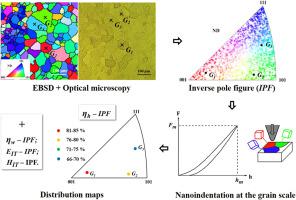Journal of Alloys and Compounds ( IF 6.2 ) Pub Date : 2021-09-26 , DOI: 10.1016/j.jallcom.2021.162112 Y. Zhou 1 , A. Fillon 1 , D. Laillé 1 , T. Gloriant 1

|
Nanoindentation was combined with electron backscatter diffraction (EBSD) to investigate the crystallographic anisotropy of indentation responses of individual grains in the superelastic Ti2033 alloy. The high statistic of measurements from grains oriented over a large range of crystallographic directions facilitated a fundamental study covering the entire stereographic triangle of the β phase. For a highlighted visual effect, results were presented as inverse pole figure distribution maps of depth recovery, work recovery, indentation modulus and hardness. Results showed that the pronounced anisotropy behaviors of indentation modulus, depth and work recovery ratios resulted from the anisotropy in Young’s modulus and in compressive lattice distortion between the bcc structure of β phase and the orthorhombic structure of the stress-induced α’’ martensite phase, respectively. However, orientation dependence was gone when plasticity occurred. The orientation-independency in indentation hardness was due to the various slip systems that might be activated within bcc crystals.
中文翻译:

Ti-20Zr-3Mo-3Sn合金超弹性和机械性能的晶体各向异性由晶粒尺度的纳米压痕证明
纳米压痕与电子背散射衍射 (EBSD) 相结合,以研究超弹性 Ti2033 合金中单个晶粒的压痕响应的晶体学各向异性。在大范围结晶方向上取向的晶粒测量的高统计数据促进了涵盖 β 相的整个立体三角形的基础研究。为了突出视觉效果,结果以深度恢复、功恢复、压痕模量和硬度的反极图分布图形式呈现。结果表明,压痕模量具有明显的各向异性行为,深度和功恢复率分别由杨氏模量的各向异性和 β 相的 bcc 结构和应力诱导的 α'' 马氏体相的正交结构之间的压缩晶格畸变引起。然而,当可塑性发生时,取向依赖性就消失了。压痕硬度的取向无关性是由于可能在 bcc 晶体内激活的各种滑移系统。



























 京公网安备 11010802027423号
京公网安备 11010802027423号